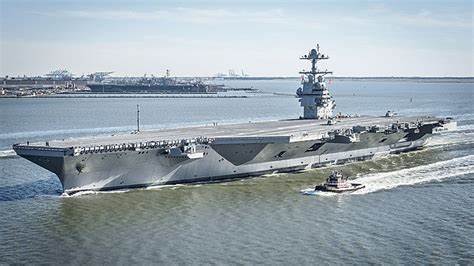
The USS Gerald R. Ford, the U.S. Navy’s most sophisticated and largest aircraft carrier, embarked on an emblematic mission in the Eastern Atlantic on November 8, 2022.

As part of the NATO exercise Silent Wolverine, the supercarrier, alongside six NATO allies, retraced WWII supply routes, reaffirming the transatlantic bond and shared commitment to security.

The USS Gerald R. Ford (CVN 78) is the epitome of naval engineering.

It features 23 new technologies that demonstrate notable progress in propulsion, power generation, ordnance handling, and aircraft launch systems.

These innovations promise an amplified aircraft launch and recovery capacity, even with a crew size 20 percent smaller than that of its predecessors in the Nimitz class.

Measuring 337 meters long and 78 meters wide, the USS Gerald R. Ford Class carriers have a total load displacement of 100,000 tons.

The flight deck, spanning 78 meters, is equipped with an electromagnetic aircraft launch system and advanced arresting gear.

This aircraft carrier can house more than 75 aircraft and accommodate 4,539 personnel.

With propulsion from two nuclear reactors, it is armed with various weapons such as RIM-162 Evolved Sea Sparrow missiles, Airframe Missiles, and Phalanx close-in weapon systems (CIWS).

This advanced capability was put to the test during the exercise, with Canada, Denmark, Germany, France, the Netherlands, and Spain participating in high-end naval warfare scenarios to gauge Ford’s operational readiness and combat support potential.

Rear Admiral Greg Huffman, commander of Carrier Strike Group 12, expressed pride in the multi-national operation: “We are honored to be sailing alongside some of the most capable navies in the world during our first deployment as we increase our proficiencies and demonstrate the warfighting capabilities that Ford brings to the fight.”

Composing the Gerald R. Ford Carrier Strike Group are the Ticonderoga-class guided-missile cruiser USS Normandy (CG 60) and Arleigh Burke-class guided-missile destroyers USS McFaul (DDG 74) and USS Thomas Hudner (DDG 116).

This deployment marks Ford’s first to the U.S. European Command (EUCOM) area of responsibility.

As operations continue, the USS Gerald R. Ford is expected to undergo more evaluations to confirm its effectiveness in launching aircraft more efficiently than older carriers.

This will determine whether America’s costliest and most formidable carrier has indeed transitioned out of its test phase, as claimed by its captain, Rick Burgess, who professed: “I really grew to love this ship, and I honestly believe that it is everything that the American taxpayers hoped it would be and more.”
Relevant articles:
– Middle East mission was a chance to justify aircraft carrier’s price tag, npr.org
– 15 Best Aircraft Carriers in the World, ssbcrack.com
– Navy’s newest aircraft carrier joins allies for exercise Silent Wolverine, Naval Forces Europe (.mil), Nov 9, 2022
– US Navy’s CVN 78 joins allies for exercise Silent Wolverine, Naval News, Nov 9, 2022

